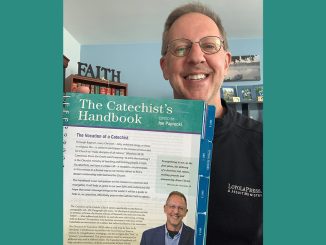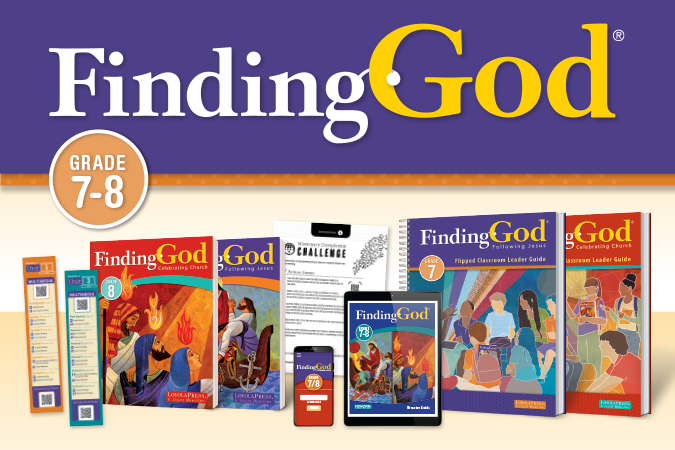
Years ago, a very wise person—Sr. Marlene Halpin, O.P.—explained that the reason young people walk away from the Catholic faith after Confirmation is because they never developed an affective relationship with Jesus Christ. As a result, they are walking away from a “subject”—religion—in the same way they walk away from other subjects they learn in school but are not particularly interested in. Today, as we continue to see the “hemorrhaging” of young Catholics from the Church, we in the catechetical ministry are urgently searching for answers, and many of our efforts are rightly focused on facilitating meaningful encounters with Jesus Christ so that young people develop a relationship with him.
As often happens, however, there is a “swinging of the pendulum” in the opposite direction that overcompensates. Some in the catechetical ministry recognize the problem as described by Sr. Marlene and are reacting by claiming that the solution is to “get rid of textbooks,” which represent, to them, an over-intellectualization of faith formation. In the place of textbooks, they want “engaging activities” to keep young people interested.
Now, if you’ve been reading my blog for the past decade or so, you know that no one is more interested in or has advocated more for “engaging activities” than yours truly. However, I have never advocated for the elimination of textbooks, and that’s not just because I work for a Catholic publisher! When I began in ministry nearly 40 years ago, first as a high-school religion teacher and then as a parish catechetical leader, neither program I inherited used textbooks. And, while I found much to like about both programs, I quickly began advocating for the inclusion of a textbook. Why? Because the God we are called to enter into relationship with has revealed himself through concrete words and actions.
When we enter into a deep and meaningful relationship with someone, we seek to know all we can about that person. If you were to ask me to talk about my relationship with Joanne, my wife of 37 years, and I struggled to recall/describe the color of her eyes, the shape of her face, where and when she was born, how we met, what her favorite foods, movies, and music are, what her joys, fears, hopes, and dreams are, and so on, you would wonder if we were truly in love. A loving relationship begins and is nurtured because two people reveal specific and concrete realities about themselves to one another. A famous episode of Seinfeld is illustrative of this. In this episode, Jerry is involved in many engaging activities with a young lady and their relationship seems to be growing, but there is one big problem: Jerry doesn’t know her name! Hilarity ensues. Of course, the hilarity includes (spoiler alert) the end of the relationship, because without basic knowledge of his girlfriend—her name—there can be no real relationship.
The bottom line is, we need to be able to talk about the One we love/Who loves us. Faith formation that is full of “engaging activities” but is devoid of solid and concrete content results in young people falling in love, not with a Person, but with engaging activities remotely related to that Person. Textbooks provide the solid and concrete content that puts flesh on the God who became flesh. That does not, however, make the textbook the be-all-and-end-all of a catechetical session. Few things are more boring than read-discuss-read-discuss. We need to train catechists to establish a climate of encounter (with God and one another) within which the content of our faith is delivered so that young people can learn about the Person they are coming to know. This means that a catechetical session should establish a climate of encounter through meaningful experiences of prayer that involve a language of mystery: sign, symbol, ritual, movement, gesture, music, silence, and sacred art. The climate should also be established through engaging activities that provoke thought, introduce and reinforce the theme/concept being taught, and build community. Within this context, the content is introduced, most often by engaging with a textbook that ensures that the content is reliable and complete (in conformity with the Catechism). And there are ways of engaging with a textbook that go beyond read-discuss-read-discuss. (See my series of posts on Creative Approaches to Reading from a Textbook.) In my experience as a catechist, reading from a textbook is typically no more than 25–40% of the total experience.
For more on how to accomplish the above, read my book, Beyond the Catechist’s Toolbox.
We need to help young people develop an affective relationship with Jesus Christ, but we do them no favors by getting rid of textbooks. When implementing new catechetical strategies, we need to stop “throwing the baby out with the bath water.”





As usual, Joe, you score several strong points, but, also, the Bishops’ committee on textbook approval reformatted many textbooks to be almost exclusively doctrine oriented instead of life oriented that you advocate. Have religious education textbooks transcended this obstruction in more recent years? Ihope so.
Hi Peter and thanks for your comment and question. This is indeed a challenge for us as publishers but, along with my colleagues at Loyola Press, we are passionately committed to finding the right balance!
I couldn’t agree more! Language, both oral and written, is symbolic communication that actually forms us as humans – and God speaks, communicates through ‘both species’ of language. We believe that our experience of Jesus moved from a direct historical encounter, through oral tradition, into written form. To deny the gift and the power of the written word is to eliminate a major step on the journey of our relationship with Christ. I prefer trying to provide a balance between encounter and processing, the need for both. Textbooks help us process and ponder the story in a concrete way.
Thanks for adding your thoughts, Kathy! I always value your insights and opinions.